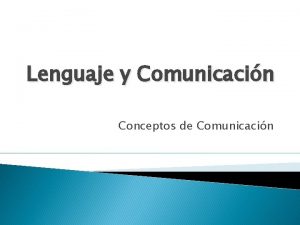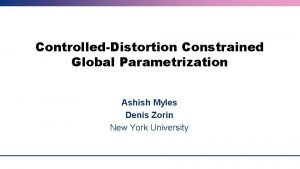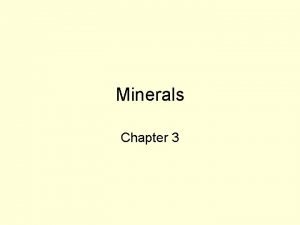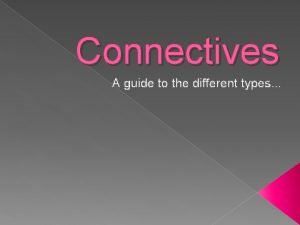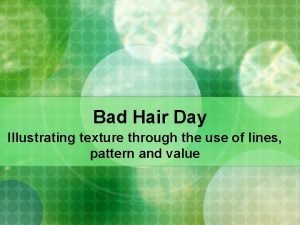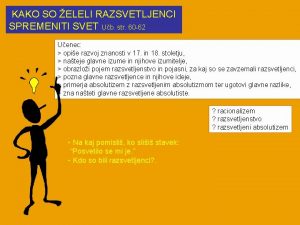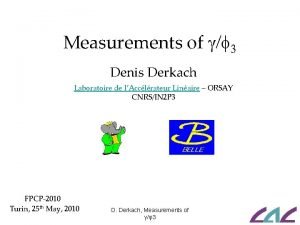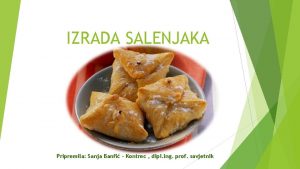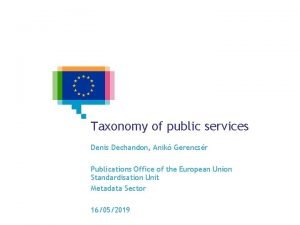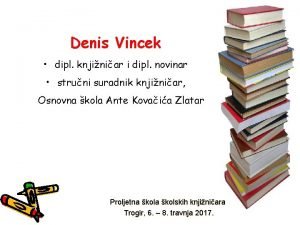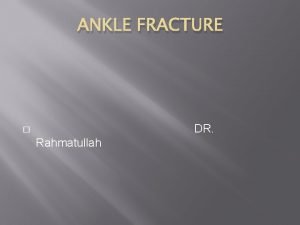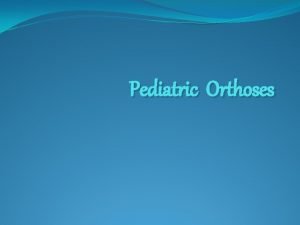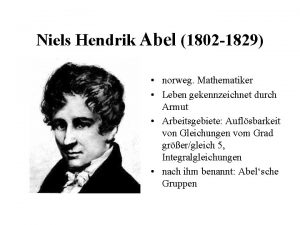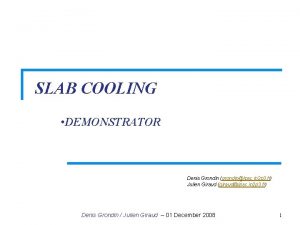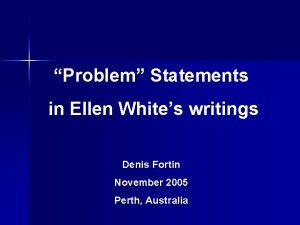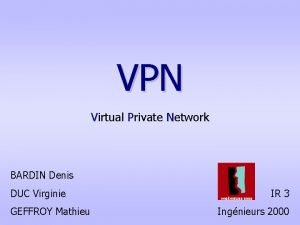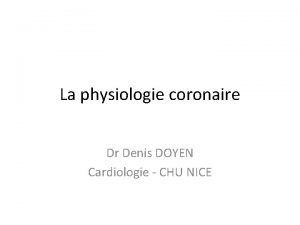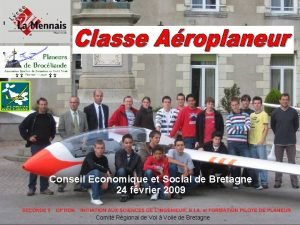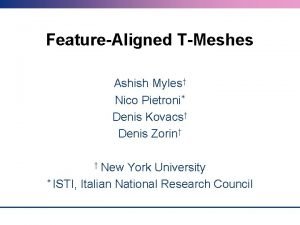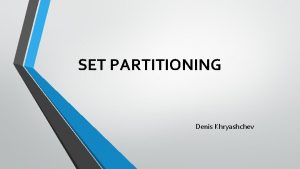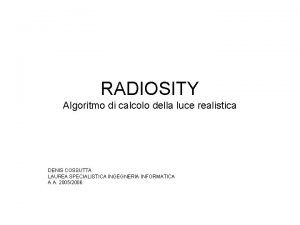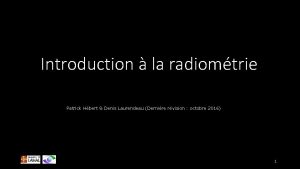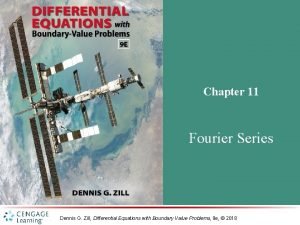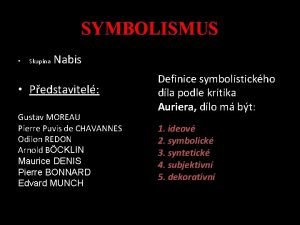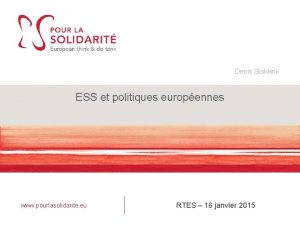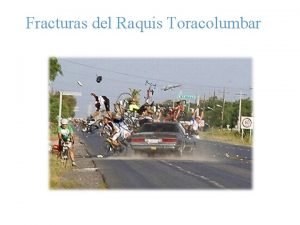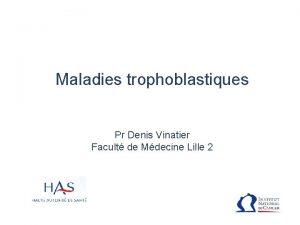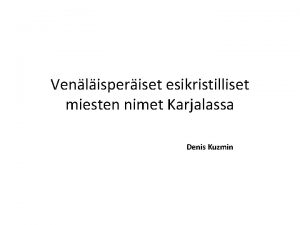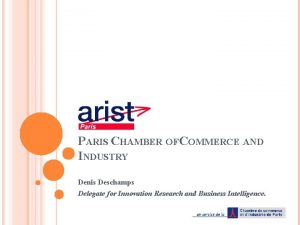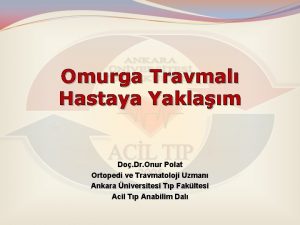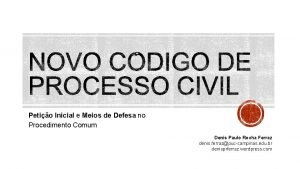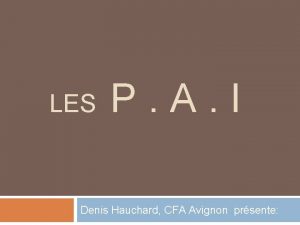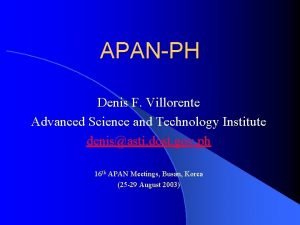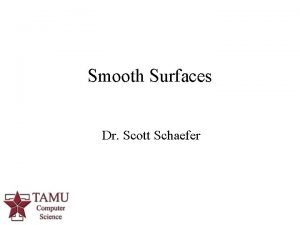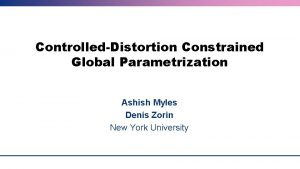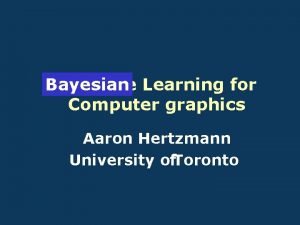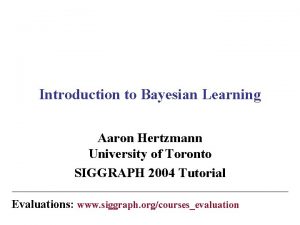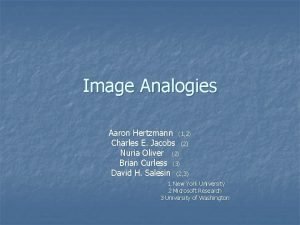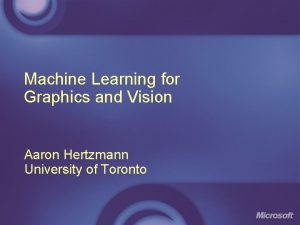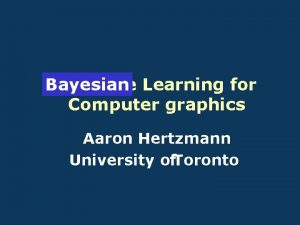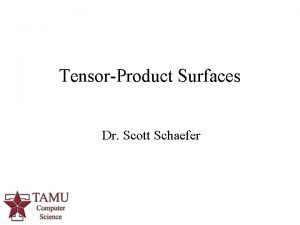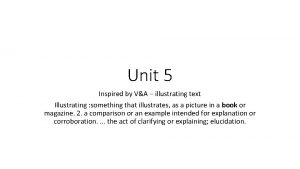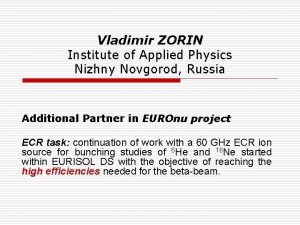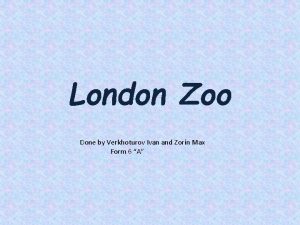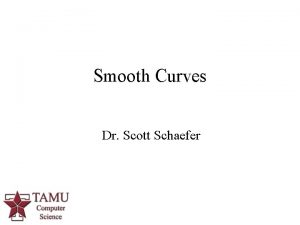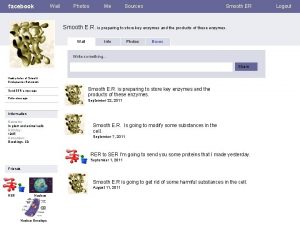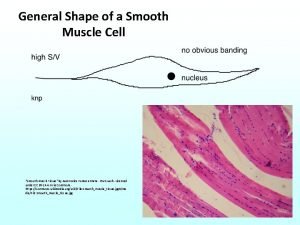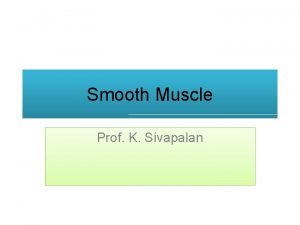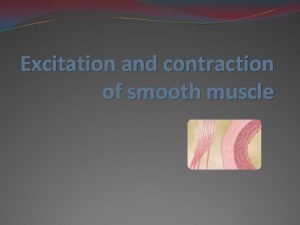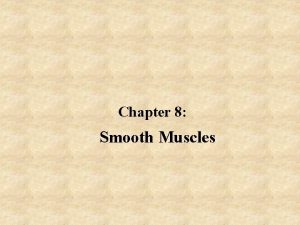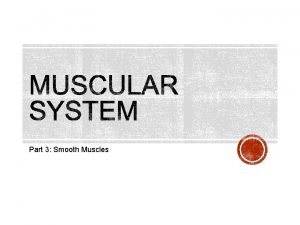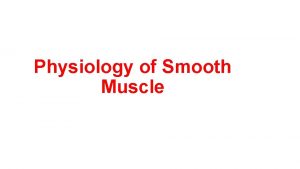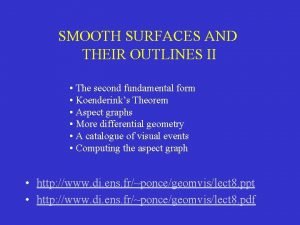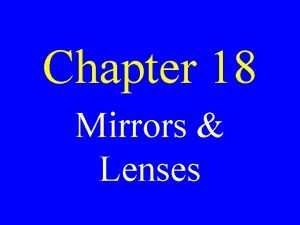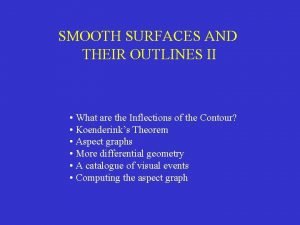Illustrating Smooth Surfaces Aaron Hertzmann Denis Zorin New






































- Slides: 38

Illustrating Smooth Surfaces Aaron Hertzmann Denis Zorin New York University Presented by Mark Blackburn, Fall 2005

Organization 1. 2. 3. 4. 5. 6. Motivation Contributions Related Work Process Results Conclusion & Future Work

Motivation • Silhouette drawing often insufficient for drawing objects that are complex or free-form. • A smooth object may have no visible silhouette lines except the outer silhouette and all the information inside the silhouette may be lost (cf. Figure 1) • Adding lines can convey the complexity of the shape • Line drawing often conveys info better than a photograph. Figure 1

Contributions Three Algorithms 1. Silhouette detection 2. Cusp detection and segmentation 3. Computing smooth direction fields

Related Work • Image-space vs. Object-space NPR • Silhouette detection – Randomized algorithm (fast, but does not guarantee to find all surfaces) – Gauss map (only works in orthographic projection) • This paper presents an algorithm that is fast, deterministic, and is applicable to orthographic as well as perspective projections

Related Work • Computing smooth direction fields: – Parametric lines on NURBS • Parameterization does not exist for many types of surfaces – Principal Curvature Hatching • Can’t be reliably or uniquely computed at many surface points – Intersections of the surfaces with planes • Requires segmentation of the surface into parts where different groups of planes are used • Plane orientations computed using skeletons relate only indirectly to the local surface properties

Process Overview Input: Polygonal Mesh (Stage 1) Hatch Direction Field: Defines a view-independent crossfield that can be used later to generate hatches (Stage 2) Silhouette Curve computation: Computes all curves, creases, cusps, and determines the visibility and segmentation of all silhouette curves (Stage 3) Hatch Generation: Divides surface into four levels of brightness (highlights, midtones, shadows, and undercuts) and generates hatches for each area of the surface Output: Illustrated Image

Stage 1: Hatch Fields • Determine hatch direction fields for entire surface Choice of direction field algorithm guided by these three observations: 1. 2. 3. Surface geometry is rendered best by principal curvature directions on cylindrical surfaces Isoparametric lines work well as curvature directions when a parameterization exists and is close to isometric Artists tend to use relatively straight hatch lines, even when the surface has wrinkles. Smaller details are conveyed by varying the density and the number of hatch directions.

Stage 1: Hatch Fields Simple requirements for hatching fields • In areas where the surface is close to parabolic, the field should be close to principal curvature directions • On the whole surface, the integral curves of the fields should be close to geodesic • If the surface has small details, the field should be generated using a smoothed version of the surface

Stage 1: Hatch Fields Four steps to determine hatch direction field 1. (Optional) Create a smoothed copy of the original mesh (User specified) 2. Identify areas of surface which are sufficiently close to parabolic 3. Initialize field over the surface by computing principal curvature directions 4. Fix the quasi-parabolic areas and *optimize* the rest of the vertices.

Stage 1: Hatch Fields (a) Silhouettes alone do not convey the interior shape of the surface. (b) Raw principle curvature directions produce an overly-complex hatching pattern. (c) Smooth cross field produced by optimization.

Stage 1: Hatch Fields (d) Hatching with the smooth cross field. (e) Very smooth cross field produced by optimizing all directions. (f) Hatching from the very smooth field.

Stage 2: Silhouette Curves Definition • A silhouette drawing includes only the images of the most visually important curves on the surface: boundaries, creases, silhouette lines, and self-intersection lines

Stage 2: Silhouette Curves • Problem: There are significant differences between the silhouettes of smooth surfaces and their approximating polygonal meshes • For polygonal meshes, complex cusps, where several silhouette chains meet, are stable (do not disappear when the viewpoint is perturbed) • For smooth surfaces, the only type of stable singularity is a simple cusp.

Stage 2: Silhouette Curves Examples

Stage 2: Silhouette Curves • Silhouette detection: – First, we find the silhouette set – Silhouette set is the set of points p of the surface such that: g(p) = (n(p) • (p-c)) = 0 – We compute an approximation to g(p) by computing the true surface normal and g(p) for each vertex and then linearly interpolating the values of the function. – The zero set of this function will consist of line segments inside each triangle of the polygonal approximation.

Stage 2: Silhouette Curves • Cusp Detection: cusps are the points where the tangent plane is parallel to the view direction • Cusp function: C(p) = K 1(v • w 1)2 +K 2(v • w 2)2 K 1, K 2 Principle curvatures View dir (Viewpoint – surface point) v w 1, w 2 Principle curvature directions

Stage 2: Silhouette Curves • Cusps are contained in the intersection set of the two families of curves: the zero set of g(p) and zero set of C(p). Cusps = { g(p) = 0 C(p) = 0} Silhouette curve Cusp zero set

Stage 2: Silhouette Curves • Optimization: Eliminate need to traverse entire mesh. • Duality Map: Map surface M M’ • M’ can be obtained by mapping each point of M to a homogeneous point N = [n 1, n 2, n 3, - (p • n)] where n = [n 1, n 2, n 3, 0] is the unit normal at p.

Stage 2: Silhouette Curves • If we let C = [c 1, c 2, c 3, c 4] be our viewpoint in the homogeneous form, then the silhouette of the surface consists of all points p for which C is in the tangent plane at that point. • Finding the surface is reduced to the problem of intersecting a plane with a surface for which many space-partition-based acceleration techniques are available.

Stage 2: Silhouette Curves Dual Map Yellow arrow vector c from origin to viewpoint Yellow circle intersection of plane ┴ to c , through origin and unit sphere Cyan Points a silhouette point and its dual

Stage 2: Silhouette Curves Planar Projections

Stage 2: Silhouette Curves 1. 2. 3. 4. Fast Silhouette Detection For each vertex p, with normal n, we compute the dual position N = [n 1, n 2, n 3, - (p • n)] Normalize each dual position N using l∞-norm Each triangle of dual mesh is assigned to a list for every 3 D space in which it has a vertex An octree is constructed for each 3 D face and the triangles assigned to this face are placed in the octree

Stage 3: Hatch Generation • Surface is separated into four levels of hatching: Level Highlights & Mach Bands Midtones Shadowed Regions Undercuts Hatching None Single hatching Cross-Hatching Dense Cross. Hatching

Stage 3: Hatch Generation (a) 3 Densities: highlights, midtones, and shadows, corresponding to 0, 1, and 2 directions of hatches (b) Undercuts (c) “Mach bands. ” Undercuts and Mach bands increase contrast where surfaces overlap.

Stage 3: Hatch Generation • Basic rules: – If there is an undercut, on the other side of the silhouette from a fold, a thin area along the silhouette on the fold side is not hatched – Undercuts are densely hatched – Hatches are approximately straight – Optionally, hatch thickness within each density level can be made inversely proportional to lighting

Stage 3: Hatch Generation • Hatching has several user tunable parameters: 1. 2. 3. 4. 5. 6. • Basic hatch density Hatch density for undercuts Threshold for highlights Threshold for transition from single to cross hatch Max hatch length Max hatch deviation from initial direction Varying these parameters has considerable effect both on the appearance of the images and the time required by the algorithm

Stage 3: Hatch Generation • Hatch placement process: 1. Identify Mach bands and undercuts 2. Cover single and cross-hatch regions with cross hatches, and add extra hatches to undercut regions 3. Remove cross-hatches in the single hatch regions, leaving only one direction of hatches

Stage 3: Hatch Generation • Identifying Mach Bands – Step along each silhouette and boundary curve – Use ray test near each curve point to determine if fold overlaps another surface – Undercuts and Mach Bands are indicated in a 2 D grid by marking every grid cell within a small distance of the fold on the near side of the surface as a Mach Band

Stage 3: Hatch Generation • Cross-Hatching: – Create evenly spaced cross hatches on a surface – Creates a queue of surface curves – Dequeue each curve and seed it with cross-hatches by tracing direction of field – Hatches are also seeded parallel to other hatches (distance determined by tunable param) – Hatches are seeded perpendicular to all curves – A hatch continues along a curve until it terminates in a critical curve, deviates from direction more than ‘Max’ param, or until it comes near a parallel hatch

Stage 3: Hatch Generation • Hatch Reduction – Once we have cross-hatched all hatch regions, we remove hatches from the single hatch regions until they contain no cross-hatches – Algorithm implicitly segments the visible single -hatch regions into locally consistent single hatching fields – Use a breadth-first traversal of hatches.

Results

Mathematical surfaces Results

Results

Results

Conclusion • Advantages: – Beautiful images that mirror pen-and-ink illustrations – Technique can be used in orthographic or perspective projections – User tunable • Disadvantages: – Performance varies significantly based on parameters and model (seconds to minutes) – Parameters have to be chosen carefully which may take several iterations to get desired result

Future Work • Improvements should be made to the silhouette visibility algorithm • Performance speedups are possible • Reduce the number of user parameters • Hatch reduction algorithm could be more robust

References • Aaron Hertzmann and Denis Zorin, "Illustrating Smooth Surfaces, " Siggraph 00, pp. 517 - 526.
 Z.m.zorín
Z.m.zorín Arie zorin
Arie zorin The splitting of a mineral along smooth flat surfaces
The splitting of a mineral along smooth flat surfaces Step in planning process
Step in planning process Qualifying connectives
Qualifying connectives Illustrating hair
Illustrating hair Illustrating connectives
Illustrating connectives Nemški filozof imanuel
Nemški filozof imanuel Denis derkach
Denis derkach Denis vincek
Denis vincek Denis dechandon
Denis dechandon Denis vincek
Denis vincek Denis weber classification
Denis weber classification Papoose infant spinal immobilizer
Papoose infant spinal immobilizer Norweg. mathematiker
Norweg. mathematiker Denis saint-amand
Denis saint-amand Denis grondin
Denis grondin Denis fortin age
Denis fortin age Mr denis aymet
Mr denis aymet Denis bardin
Denis bardin Denis doyen
Denis doyen Aéroplaneur
Aéroplaneur Denis kovacs
Denis kovacs Denis khryashchev
Denis khryashchev Denis cossutta
Denis cossutta Surface lambertienne
Surface lambertienne Denis g zill
Denis g zill Denis knaepen
Denis knaepen Moreau zjevení
Moreau zjevení Denis stokkink
Denis stokkink Pundm
Pundm Clasificacion ao fracturas vertebrales
Clasificacion ao fracturas vertebrales Denis vinatier
Denis vinatier Denis kuzmin
Denis kuzmin Denis deschamps
Denis deschamps Denis sınıflaması
Denis sınıflaması Denis paulo rocha ferraz
Denis paulo rocha ferraz Denis hauchard
Denis hauchard Denis f. villorente
Denis f. villorente
